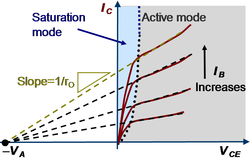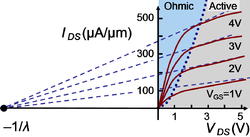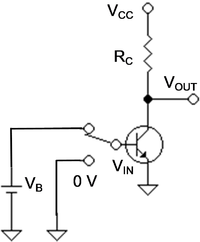Mode (electronics)
In electronics, the mode of an electrical device refers to a range of operation set by its bias condition or, when no signals are present, by its operating point or Q-point (quiescent point). In analog circuits the so-called active mode of the device is chosen by the circuit designer to allow adequate signal amplitude and adequate voltage or current gain, along with acceptable signal distortion. In digital circuits, a device toggles between the off-mode (or cutoff mode) and the on-mode (or saturation mode in bipolar transistors, or ohmic mode for MOSFET's), and visits the active mode only briefly while switching between the on and off modes.
For historical reasons, the saturation mode of the MOSFET refers to its active mode, while the saturation mode of the bipolar transistor invariably refers to its on mode. This confusion of terminology does nothing to clarify discussion.
Bipolar junction transistor
| Bipolar transistor | B-E Junction Bias |
B-C Junction Bias |
Mode |
|---|---|---|---|
| E injects, C collects | Forward | Reverse | Active (Forward-active) |
| E and C inject | Forward | Forward | Saturation |
| No injection | Reverse | Reverse | Cutoff |
| C injects, E collects | Reverse | Forward | Reverse-active |
In the bipolar device, the emitter is designed for efficient injection, while the collector is designed to collect with low capacitance between collector and base. Thus, the bipolar device is inherently asymmetrical, and a distinction between forward and reverse modes of operation makes sense.
The figure shows two of the bipolar modes dividing a plot of transistor collector current versus collector-emitter voltage. The dividing curve is the current for VCE=VBE, or VCB=0. In words, this curve is the boundary between the collector collecting and the collector injecting. The saturation mode at low values of VCE is a region of strong current variation, while the active mode is a region of slow variation used in analog circuits. The inverse slope of the curves in the active region is the device output resistance, often approximated by the inverse slope of a fitted straight line that extrapolates to the device Early voltage, a performance parameter of the device. More detail is found in the article Bipolar transistor.
MOSFET
| MOS transistor | G-S Bias |
G-D Bias |
S-B Bias |
D-B Bias |
Mode |
|---|---|---|---|---|---|
| Channel at source end only | ≥ VT(S) | ≤ VT(D) | Zero or Reverse | More reverse than S-B | Active (Saturation) |
| Channel at both ends | ≥ VT(S) | > VT(D) | Zero or Reverse | More reverse than S-B | Ohmic (Triode)[1] |
| No channel | < VT(S) | < VT(D) | Zero or Reverse | Zero or reverse | Cutoff (Subthreshold) |
In the MOSFET, the threshold at source (or drain) is altered by the source-to-body (or drain-to-body) voltage, requiring a larger gate-to-source (gate-to-drain) voltage for channel formation the larger the reverse bias. Hence, the two threshold voltages VT(S) and VT(D) are different if the two reverse biases differ.
The term "cutoff" seems to imply no current flow at all, so for the MOSFET the term "subthreshold" sometimes is preferred. In subthreshold operation the current in the MOSFET decreases to very low values exponentially with gate voltage, and has very weak dependence upon drain-to-source voltage.
The table separates modes based upon the presence or absence of an inversion layer, or channel, at one or both ends of the channel region, concepts that retain meaning even for modern MOSFETs with very small dimensions and/or four-terminal operation. On the other hand, the obsolete Shichman-Hodges model that short-circuits the source to the body to obtain a three-terminal representation, bases the distinction between modes upon voltages: VDS < ( VGS – VT ) or VDS > ( VGS – VT ), a more limited approach.
In the MOSFET, the source and drain are interchangeable, so reverse operation simply exchanges the source for the drain. An exception is the power MOSFET, which like the bipolar transistor, has source and drain separately optimized for their particular function.
The figure shows two of the MOSFET modes dividing a plot of transistor drain current versus drain-source voltage. The body is short-circuited to the source. The boundary curve is the line VGD = VT (where V T is the threshold voltage for channel formation). In words, this curve is the current at a drain voltage high enough to extinguish the channel near the drain. The ohmic or triode mode at low values of VDS is a region of strong current variation, while the active or saturation mode is a region of slow variation used in analog circuits. The inverse slope of the curves in the active region is the device output resistance, often approximated by the inverse slope of a fitted straight line that extrapolates to the device Early voltage, a performance parameter of the device. In MOSFETs, the Early voltage VA usually is replaced by VA=1/λ, where λ is called the channel-length modulation parameter. More detail is found in the article MOSFET.
"On" and "off " modes
The use of on- and off-modes is illustrated with the bipolar inverter circuit shown at the right. The circuit switches between "on" and "off" states (digital "one" and "zero") as the input VIN switches from "zero" to "one". That is, the output is the inverse of the input. The way things work is described next.
The input is shown as a switch that can toggle between ground (a "zero" input) and some nonzero voltage (a "one" input). The "one" input position is shown in the figure. It applies voltage VB to the base of the bipolar transistor, making the base-emitter voltage of this transistor VBE=VB. The value of VB is large enough to cause a large collector current to flow through the resistor, so large that the collector voltage VC=VOUT is so low that the transistor is driven into saturation mode. That is, the collector is biased to inject carriers. The output voltage is VCE(sat), the collector emitter voltage when the transistor is in saturation. This low output voltage is the "zero" level for the inverter output, and the saturation mode of the transistor is is the "on" mode.
If now the switch were flipped to the ground position, the input would be VIN=0 V. The transistor VBE would be 0 V, and no collector current would flow. Consequently the voltage drop across the resistor would be zero, and VOUT=VCC, the supply voltage and the voltage corresponding to digital "one" for the inverter. The transistor is now in the "off" mode which is cutoff mode. In practice, the voltage corresponding to a digital "zero" or digital "one" are not precisely 0 V or VCC but a range of low voltages and a range of high voltages.
A parallel discussion applies when the transistor is a MOSFET instead of a bipolar transistor.
References and notes
- ↑ The ohmic region sometimes is divided into the linear and the nonlinear ohmic regions, which jointly sometimes are called the "triode region". See Muhammad H. Rashid (2010). “§7.3.1 Operation: Linear ohmic region”, Microelectronic Circuits: Analysis and Design, 2nd ed. Cengage Learning, pp. 339 ff. ISBN 0495667722.


